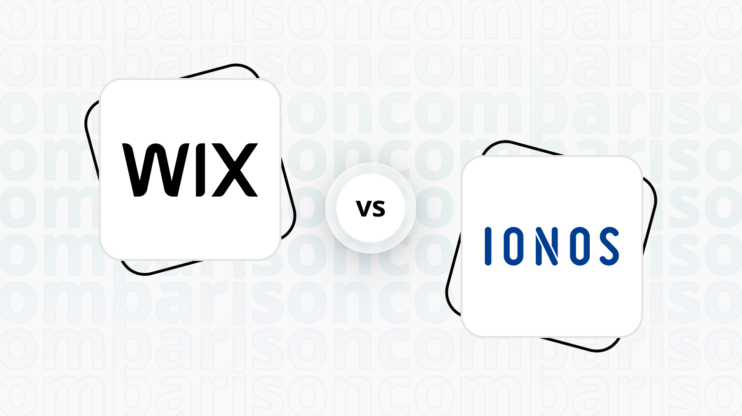SmugMug vs Adobe Portfolio: Final verdict
SmugMug and Adobe Portfolio both cater to creative professionals, but they serve slightly different needs.
-
SmugMug (Overall Grade: 6.3/10)
is a premium website builder tailored for photographers and creatives who want to showcase and sell their work online. It offers a range of customizable templates optimized for high-quality images, robust photo protection features, and ecommerce capabilities. SmugMug is ideal for photographers looking to professionalize their online presence and monetize their art efficiently. -
Adobe Portfolio (Overall Grade: 5.5/10)
is designed for creative professionals to showcase their work with visually appealing, fully responsive websites. It integrates seamlessly with Adobe Creative Cloud, making it easy to import and customize work. While it lacks ecommerce capabilities, Adobe Portfolio excels in design functionalities and ease of use, making it a great choice for creatives focused on building a professional online presence without the need for selling products.

|

|
|
|---|---|---|
|
Design functionalities & templates |
7.1 |
7.4 |
|
Ease of use |
7.8 |
8.7 |
|
Ecommerce |
7.3 |
0.0 |
|
Website Editors |
7.3 |
7.4 |
|
Product testing options |
7.4 |
7.6 |
|
Price |
7.8 |
7.7 |
|
Hosting quality |
5.0 |
7.0 |
|
Website speed optimization |
5.5 |
6.2 |
|
Plugins and integrations |
6.2 |
6.7 |
|
Marketing features |
3.8 |
3.7 |
|
Customer support |
7.9 |
7.3 |
|
Security |
6.0 |
8.1 |
|
User Management |
7.2 |
3.0 |
Which one is the best for ecommerce: SmugMug or Adobe Portfolio?
 7.3
7.3
 0.0
0.0
Verdict
: SmugMug is the clear choice for ecommerce, especially for photographers and creatives looking to sell their work online. Adobe Portfolio, while excellent for showcasing creative work, lacks any ecommerce capabilities.
-
SmugMug
: SmugMug offers a robust set of ecommerce features tailored for photographers and creatives. It supports the sale of digital downloads, prints, and merchandise, integrating with print labs for seamless order fulfillment. With tools for pricing, sales management, and marketing, SmugMug enables users to monetize their art efficiently. When comparing SmugMug vs Adobe Portfolio, SmugMug stands out for its ecommerce functionalities, scoring 7.3. -
Adobe Portfolio
: Adobe Portfolio is designed for showcasing creative work with visually appealing, fully responsive websites. However, it does not offer any ecommerce features, making it unsuitable for those looking to sell products online. In the SmugMug vs Adobe Portfolio comparison, Adobe Portfolio scores 0.0 for ecommerce capabilities.
Which one is the best for informational and business websites?
 7.5
7.5
 7.4
7.4
Verdict
: SmugMug and Adobe Portfolio are both strong contenders for creating informational and business websites, each with its unique strengths. SmugMug is slightly ahead with a score of 7.5, compared to Adobe Portfolio’s 7.4.
-
SmugMug
: SmugMug is tailored for photographers and creatives who want to showcase their work online. It offers customizable templates optimized for high-quality images and robust photo protection features. While it includes e-commerce capabilities, its primary strength lies in displaying visual content, making it a solid choice for photographers and visual artists looking to create an informational website. -
Adobe Portfolio
: Adobe Portfolio is designed for creative professionals across various fields, offering fully responsive and visually appealing websites without the need for coding. Its seamless integration with Adobe Creative Cloud and user-friendly interface make it ideal for creatives looking to build a professional online presence. When comparing SmugMug vs Adobe Portfolio, Adobe Portfolio’s flexibility and ease of use make it a strong contender for informational business websites.
SmugMug vs Adobe Portfolio: Detailed comparison
Design functionalities & templates
Design FunctionalitiesRepresents how well each platform allows for creative design and customization of websites.Score Components:
- Template Variety (30%): Range and quality of design templates.
- Customization (30%): Flexibility and options for design alterations.
- User Interface (20%): Ease and intuitiveness of the design process.
- Responsiveness (10%): Adaptability to different devices and screen sizes.
- Innovation (10%): Unique design features and tools.
 7.1
7.1
 7.4
7.4
🏆
Winner: Adobe Portfolio.
Adobe Portfolio slightly edges out SmugMug in terms of design functionalities and templates, offering a more flexible and customizable platform for creative professionals.
SmugMug offers a variety of templates and designs, catering to the diverse needs of photographers and visual artists. Users can choose from an extensive collection of customizable templates, ensuring their website or portfolio reflects their unique style and brand.
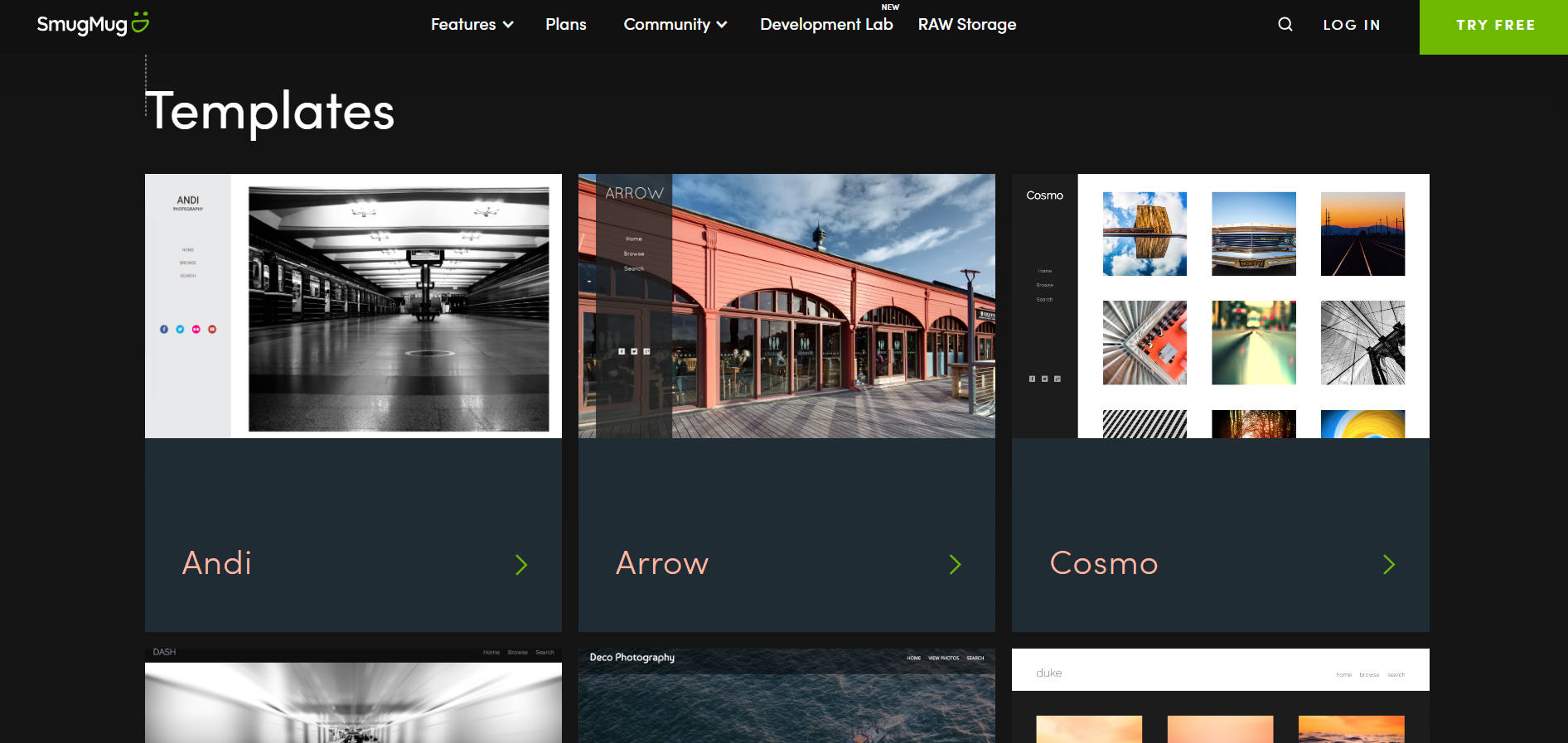
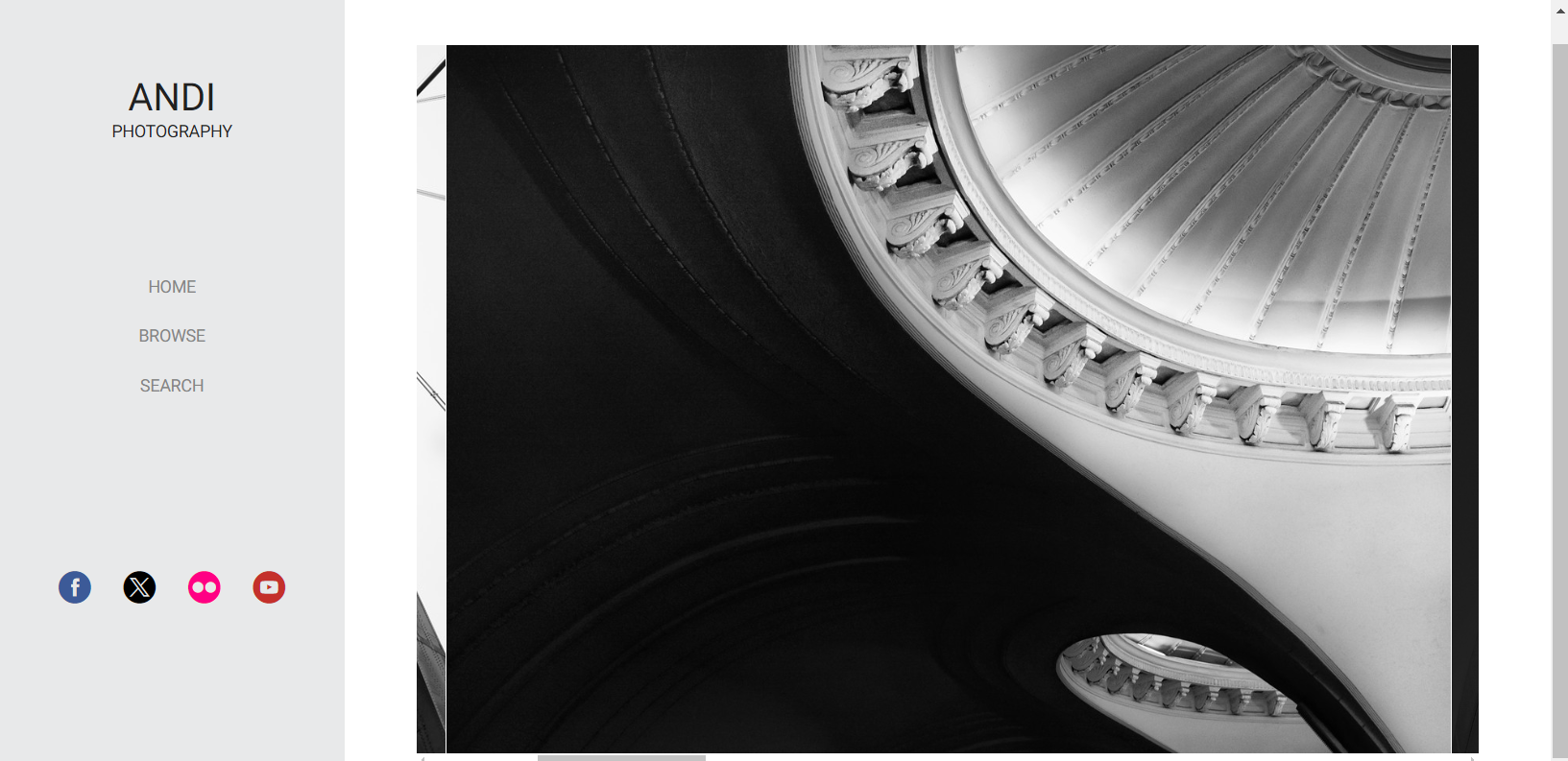
On the other hand, Adobe Portfolio offers a selection of customizable templates designed for creatives across various fields, such as photography, graphic design, and web design. These templates are responsive and tailored to showcase creative work effectively across all devices.
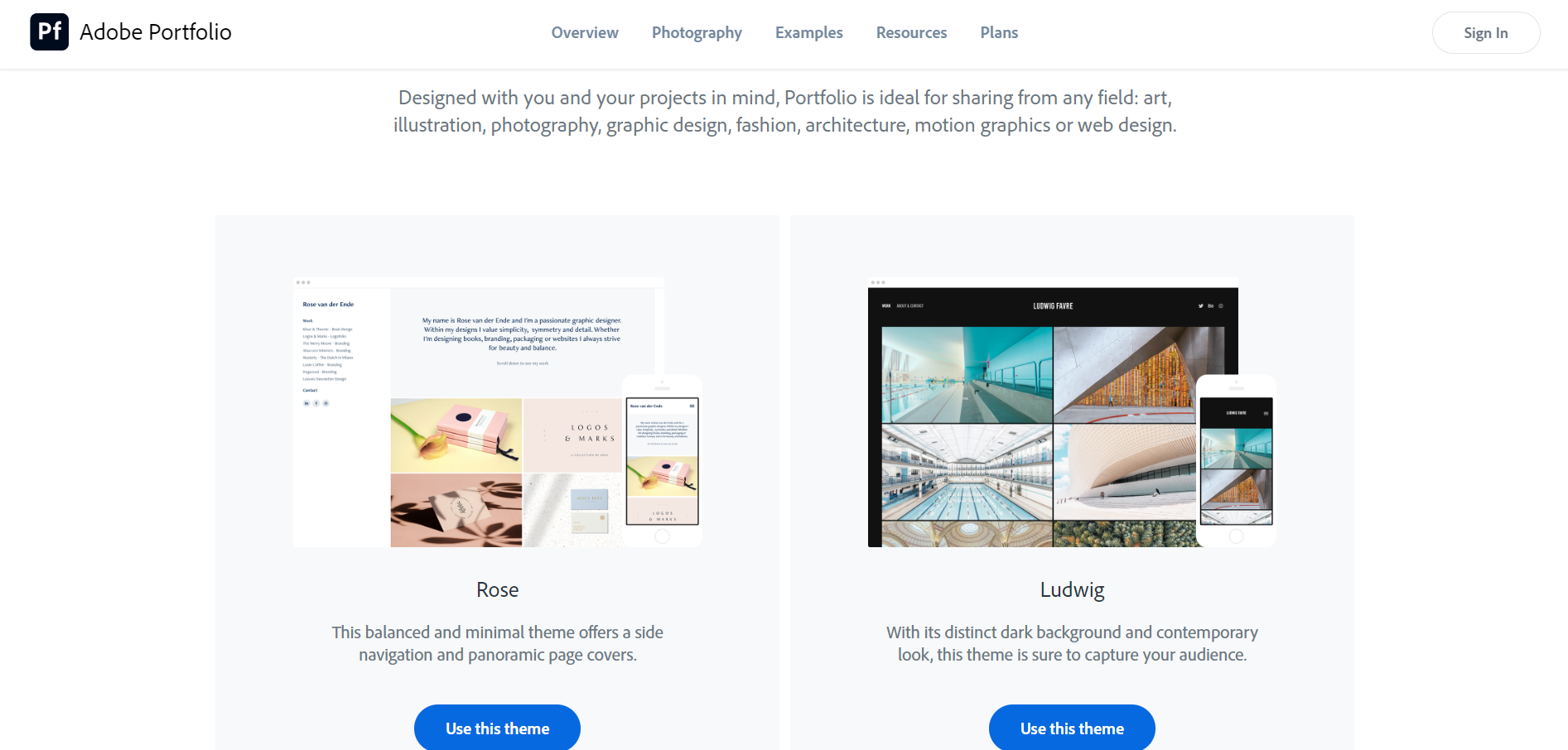
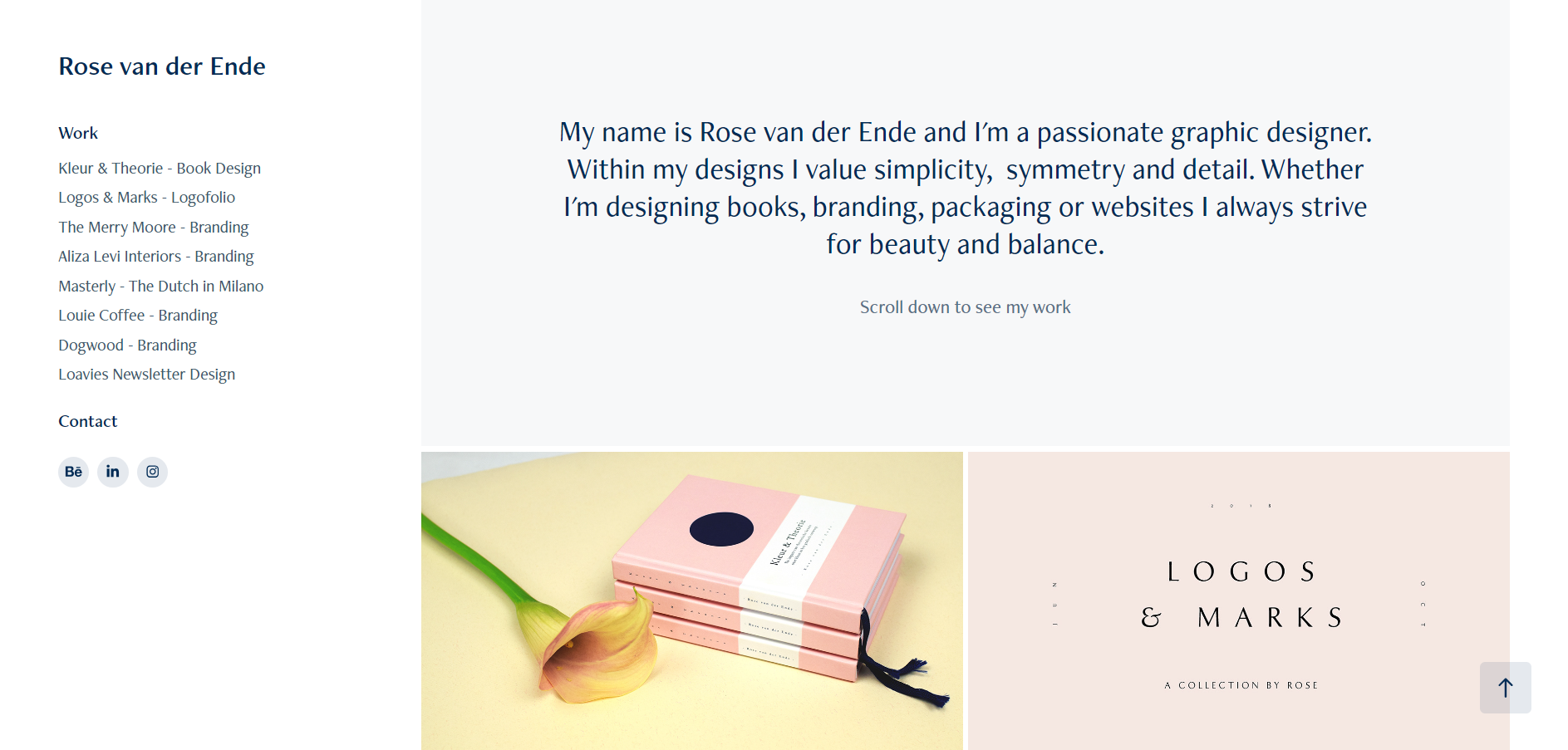
Get a head start on website creation with AI
Create a custom website tailored to your business needs 10X faster with 10Web AI Website Builder!
Ease of use
Ease of useReflects the platform’s overall user-friendliness.Score
Components:
- Learning curve (40%): Quickness and ease of getting started.
- Interface design (30%): Simplicity and intuitiveness of layout.
- User guidance (20%): Quality of tutorials and support.
- Flexibility (10%): Adaptability to various user skills.
 7.8
7.8
 8.7
8.7
🏆 Winner: Adobe Portfolio
. With a score of 8.7, Adobe Portfolio outperforms SmugMug, which scored 7.8. Adobe Portfolio’s user-friendly interface and seamless integration with Adobe Creative Cloud make it an excellent choice for creatives looking to showcase their work with minimal fuss. SmugMug, while also user-friendly, is more specialized for photographers and may not be as versatile for other types of websites.
Learning Resources
🏆 Winner: Adobe Portfolio
. Adobe Portfolio offers extensive and varied learning resources, including detailed tutorials and interactive guides, making it easier for users to create and manage their online portfolios. SmugMug also provides learning materials, but they are not as comprehensive as Adobe Portfolio’s.
For ecommerce
EcommerceMeasures the platform’s effectiveness in supporting online business activities.Score Components:
- Ecommerce themes and templates (20%): Variety and design of templates.
- Product management (25%): Ease of managing and organizing products.
- Payment options (25%): Variety and convenience of payment methods.
- Ecommerce features (20%): Features for managing an ecommerce store.
- Integration (10%): Compatibility with external e-commerce tools and services.
 7.3
7.3
 0.0
0.0
When it comes to ecommerce, SmugMug and Adobe Portfolio cater to different needs. SmugMug is designed for photographers and creatives who want to sell their work online, while Adobe Portfolio is more focused on showcasing creative work without ecommerce capabilities.

|

|
|
|---|---|---|
|
Ecommerce themes and templates |
8.0 |
0.0 |
|
Product page customization |
6.5 |
0.0 |
|
Payment processing and commissions |
6.0 |
0.0 |
|
POS capabilities |
0.0 |
0.0 |
|
Payment gateways |
5.0 |
0.0 |
|
Product numbers |
9.0 |
0.0 |
|
Additional ecommerce features |
6.5 |
0.0 |
SmugMug ecommerce features:
- Digital Downloads
- Product Pricing
- Tax handling
- Discounts and Coupons
- Multiple Currencies support
SmugMug offers a range of ecommerce features, allowing photographers and creators to sell their photos and videos directly through their SmugMug website. The platform supports the sale of digital downloads, prints, and merchandise. SmugMug integrates with print labs for order fulfillment, enabling photographers to sell their work without handling the printing and shipping process themselves. Customers can purchase various products such as photo prints, wall art, and keepsakes directly from a SmugMug gallery. SmugMug also provides tools for pricing, sales management, and marketing to help photographers and creators maximize their revenue.
Almost all of the templates of SmugMug are designed with ecommerce in mind, providing built-in shopping cart functionality. SmugMug prioritizes photography, offering a platform tailored for photographers to showcase and sell their work, despite having more limited product page customization compared to dedicated e-commerce platforms. It still provides enough functionality to detail digital and printed photography products effectively, enabling users to sell online with ease. This balance between showcasing art and facilitating sales makes SmugMug a suitable choice for photographers looking to professionalize their online presence and monetize their art efficiently.
SmugMug has a unique approach to payment processing, payment processing for your sales is managed through your account settings, where you must complete a Tax & Payment form to set up your payment preferences. You can choose your profit payment schedule, with automatic monthly payments for balances over $500, or request payments for lower amounts. Your earnings are calculated as 85% of the markup on print prices or download sales, with SmugMug retaining 15% to cover various costs. Payments are made via ACH direct deposit for U.S. users or PayPal for international users, processed on the first business day after the 7th of each month for profits accumulated through the end of the previous month.
Adobe Portfolio ecommerce features:
Adobe Portfolio does not have any ecommerce features. It is a website builder specifically designed for creative professionals to showcase their work. It allows users to create fully responsive, visually appealing websites without the need for coding knowledge. With an intuitive interface and integration with Adobe Creative Cloud, users can easily import their work and customize layouts to fit their style. Adobe Portfolio is ideal for photographers, graphic designers, artists, and other creatives looking to build a professional online presence, but it does not offer any ecommerce capabilities. Adobe Portfolio does not have any ecommerce specific templates or product page customization features. It also does not have any payment processing capabilities.
Website Editors
Website EditorsEvaluates the platforms’ website building and editing capabilities.Score Components:
- Customization tools (40%): Range and power of editing features.
- Editor usability (30%): User experience within the editor.
- Design flexibility (20%): Freedom in layout and design changes.
- Update and maintenance ease (10%): Simplicity of updating and maintaining the site.
 7.3
7.3
 7.4
7.4
🏆
Winner: Adobe Portfolio
. Adobe Portfolio, with a score of 7.4, offers a user-friendly website builder editor designed for creatives to showcase their work. With it, users can easily create and customize their own professional-looking websites without needing to code. The editor allows for the integration of high-quality images and videos, offers a variety of responsive templates tailored to different creative fields, and provides seamless Adobe Creative Cloud integration, enabling users to directly import their work. Additionally, Adobe Portfolio supports custom domain names and offers access to Adobe Fonts, enhancing the aesthetic appeal and functionality of the user’s website.
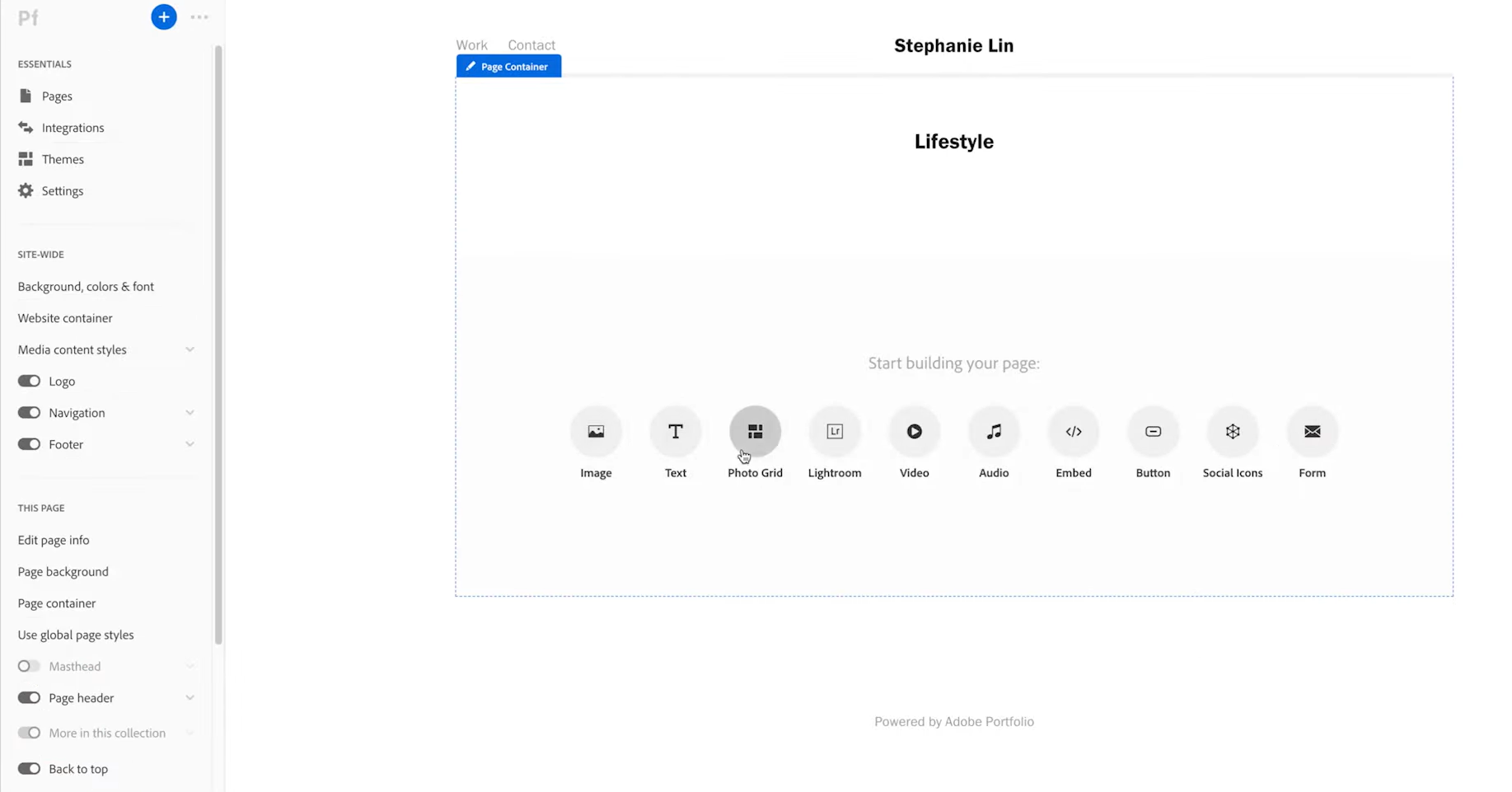
SmugMug’s website builder editor, scoring 7.3, offers a user-friendly interface that allows for the creation of visually appealing, professional-grade photography websites without the need for coding knowledge. Users can customize their site by choosing from a variety of templates, adjusting layouts, and incorporating their own branding elements like logos and colors. The editor also supports easy uploading, organizing, and showcasing of high-quality images, with robust privacy and security settings to protect content. Additionally, SmugMug provides tools for selling prints and digital downloads directly from the website, making it a comprehensive platform for photographers looking to display and monetize their work online.
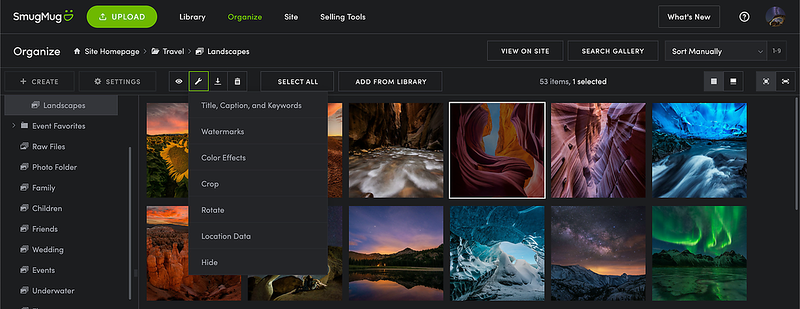
Mobile editor/app
 7.5
7.5
 0
0
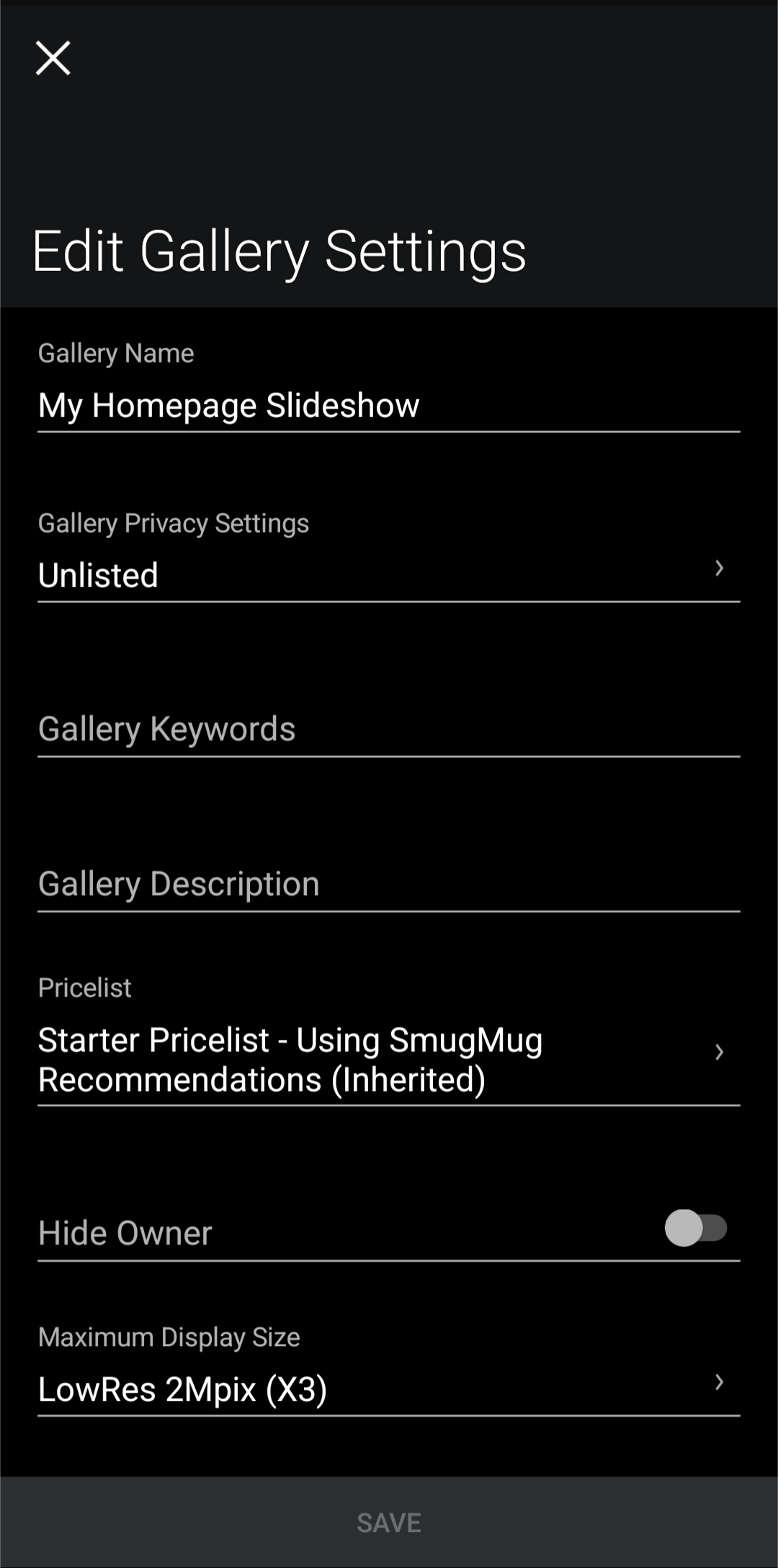
🏆
Winner: SmugMug
. Both SmugMug and Adobe Portfolio are designed for creatives, but they differ significantly in their mobile editing capabilities. SmugMug offers a mobile editing app, but its functionality is limited to adding new photos and editing descriptions. Layout changes on the website are not possible through the app.
On the other hand, Adobe Portfolio does not offer a mobile editor app at all. This lack of mobile editing capabilities can be a significant drawback for users who prefer to make changes to their website on the go.
In conclusion, while SmugMug’s mobile app has limited functionality, it still offers more flexibility than Adobe Portfolio in terms of mobile editing. Therefore, SmugMug is the winner in this category.
Product testing options
Product Testing OptionsAssesses the options for trying out platform features before commitment.Score Components:
- Trial quality (40%): Extent and usefulness of the trial or free version.
- Feature accessibility (30%): How many features are available to test.
- Trial duration (20%): Length of the trial period.
- Ease of transition (10%): Smoothness of moving from trial to paid plans.
 7.4
7.4
 7.6
7.6
Overall Result
:
Adobe Portfolio Wins
. Adobe Portfolio scores slightly higher than SmugMug with a score of 7.6 against 7.4. Both platforms do not offer a free version, but they provide different trial options. SmugMug offers a 14-day free trial, while Adobe Portfolio allows users to explore all features and even create a portfolio website using the trial version. However, users cannot publish their website without subscribing to a plan. Adobe Portfolio also offers a 14-day money-back guarantee, which SmugMug does not.

|

|
|
|---|---|---|
|
Free Plan |
No | No |
|
Trial Duration |
14 days |
Yes |
|
Testing Premium Features |
During the free trial |
During trial and 14-day refundable period |
|
Money Back Guarantee |
No |
14-day money back guarantee |
Price
PriceLooks at the cost-effectiveness and value for money of each platform.Score Components:
- Plan value (40%): What each pricing tier offers.
- Transparency and clarity (30%): Clearness of pricing structures.
- Flexibility of plans (20%): Range of options to suit different budgets.
- Hidden costs (10%): Additional expenses not included in the plan.
 7.8
7.8
 7.7
7.7
SmugMug and Adobe Portfolio have similar pricing scores, with SmugMug slightly ahead. Both platforms offer a range of plans to suit different needs, with Adobe Portfolio’s pricing tied to the Creative Cloud subscription.

|

|
|
|---|---|---|
|
$5-$20 |
Power ($15.00/month): Best for the photographer who wants their entire photo catalog safe and shareable on their own terms. Unlimited storage, Seamless Lightroom integration. Value for price: 6.5 |
Creative Cloud – Photography ($9.99/month): Up to 5 Portfolio sites with fonts from Adobe Fonts, and with access to Photoshop and Lightroom and 20GB storage. Value for price: 7.0 |
|
$30-$40 |
Portfolio ($31.00/month): Best for the photographer who wants to start selling photos and keep their archive organized perfectly. All Power plan’s features, plus 21 premade templates, prints and digital downloads sales, Custom Watermarks, Payment integration for credit cards and PayPal, Integrated cart and checkout experience, Sales statistics. Value for price: 8.0 |
No offering at this amount. |
|
$40-$60 |
Pro ($45.00/month): Adds to Portfolio with custom price lists and coupons, Platform access for assistant or second shooter, Full control over client downloads, Branded packaging and thank you notes for print sales, coupon creator. Value for price: 8.5 |
Creative Cloud – All Apps ($59.99/month): Up to 5 Portfolio sites with the entire collection of Adobe creative apps, including Photoshop, Illustrator and InDesign, with 20 GB storage. Value for price: 8.5 |
|
$500+ |
Venture (Starts with $500/month): All Pro features, plus dedicated support contacts and account representative for all Smugmug needs, Design, workflow, and organization consultation and support. |
No offering at this amount. |
location. As a result in rare cases the prices displayed here can differ from the ones you see on their
websites.
Hosting quality
Hosting
qualityExamines the reliability and performance of the hosting solutions.Score Components:
- Uptime (40%): Consistency and reliability of website availability.
- Speed (30%): Loading times and performance.
- Bandwidth and storage (20%): Sufficiency of resources provided.
- Data centers (10%): Quality and distribution of hosting infrastructure.
 5.0
5.0
 7.0
7.0
Winner: Adobe Portfolio
. Adobe Portfolio offers cloud hosting with 20GB of storage and data centers in three global locations. Although it doesn’t provide specific uptime statistics or guarantees, Adobe’s reputation suggests high reliability. SmugMug, on the other hand, offers less transparency about its hosting features, making it difficult to assess its quality.

|

|
|
|---|---|---|
|
Do they offer hosting? |
Yes | Yes |
|
Data Centers: |
Not provided | 3 globally: US, Ireland and Japan |
|
Type of hosting: |
Not provided | Cloud Hosting |
|
Uptime: |
Not provided | Not provided |
|
Uptime Guarantee: |
Yes, 99.9% | Not provided |
Website Speed Optimization
Website Speed OptimizationEvaluates optimization of website loading timesScore Components:
- PageSpeed Score (30%): Google’s score indicating performance optimization.
- Loading Time (30%): The average time until a website is fully interactive.
- Mobile Optimization (15%): Optimization effectiveness for mobile devices.
- Resource Optimization (15%): Optimizing images, scripts, and other heavy resources.
- CDN Usage (10%): Use of CDN to enhance speed across geolocations.
 5.5
5.5
 6.2
6.2
🏆 Winner: Adobe Portfolio
Both SmugMug and Adobe Portfolio are designed for creatives, with a focus on showcasing high-quality images and works. However, Adobe Portfolio takes the lead in website speed optimization due to its emphasis on image optimization and SEO configurations.

|

|
|
|---|---|---|
|
Focus |
Mobile Responsive design |
Image optimization, SEO configurations |
|
Performance Tools |
Not specified |
Not specified |
|
Key Strategies |
Mobile Responsive design |
Image optimization, SEO and Meta Tag Configurations |
|
Load Times |
Varies widely, depending on optimization and website complexity |
Varies depending on design choices and content volume |
|
Page Speed Scores Range |
Varies widely, depending on optimization and website complexity |
Varies depending on design choices and content volume |
|
Core Web Vitals Improvement |
No information available |
No information available |
Adobe Portfolio, designed for creative professionals, emphasizes on image optimization and SEO configurations for speed optimization. Although the load times and PageSpeed scores vary depending on specific design choices and content volume, Adobe Portfolio’s focus on simple portfolio websites should ensure good loading times and Page Speed scores. However, Adobe Portfolio does not disclose any information about its Core Web vitals improvements.
On the other hand, SmugMug, a premium website builder designed for photographers and creatives, focuses on mobile responsive design for speed optimization. Both the load times and Page speed scores vary widely, depending on the optimization and website complexity. SmugMug does not share any information on Core Web Vital improvements.
Get a head start on website creation with AI
Create a custom website tailored to your business needs 10X faster with 10Web AI Website Builder!
Plugins and integrations
Plugins and integrationsMeasures the range and effectiveness of additional plugins and integrations.Score Components:
- Variety of options (40%): Range of available add-ons.
- Integration smoothness (30%): Ease of integrating plugins into the site.
- Quality of plugins (20%): Functionality and reliability of the options.
- Custom integration capabilities (10%): Support for custom or third-party integrations.
 6.2
6.2
 6.7
6.7
🏆 Winner: Adobe Portfolio.
Adobe Portfolio scores 6.7, slightly higher than SmugMug’s 6.2. Adobe Portfolio’s integrations with Adobe services like Behance, Adobe Lightroom, Adobe Stock, and Adobe Fonts provide additional customization and management options for online portfolios. SmugMug, on the other hand, supports integrations with several photo-hosting services, enhancing its functionality for photographers. However, Adobe Portfolio’s seamless sharing, updating, and showcasing of creative work give it the edge in this category.
Marketing Features
Design FunctionalitiesRepresents how well each platform allows for creative design and customization of websites.Score Components:
- Template Variety (30%): Range and quality of design templates.
- Customization (30%): Flexibility and options for design alterations.
- User Interface (20%): Ease and intuitiveness of the design process.
- Responsiveness (10%): Adaptability to different devices and screen sizes.
- Innovation (10%): Unique design features and tools.
 3.8
3.8
 3.7
3.7
🏆
Overall Winner: SmugMug
. SmugMug and Adobe Portfolio both have limited marketing features, but SmugMug’s more robust social media integration gives it a slight edge.

|

|
|
|---|---|---|
|
SEO Tools |
Basic SEO tools | Basic SEO tools |
|
Email Marketing |
✗ | ✗ |
|
Blogging |
✗ | ✗ |
|
Social Media Integration |
Share content directly on social platforms | Limited social media integration |
|
Analytics and Reporting |
Google Analytics integration | Google Analytics integration |
|
Ads and Promotions |
✗ | ✗ |
Customer Support
Customer supportEvaluates the quality and availability of support options.Score Components:
- Response time (40%): Speed of support responses.
- Support quality (30%): Effectiveness and helpfulness of the support.
- Availability (20%): Range of support channels (phone, chat, email).
- Resource richness (10%): Quality of self-help and educational materials.
 7.9
7.9
 7.3
7.3
🏆 Winner: SmugMug
. In the SmugMug vs Adobe Portfolio comparison, SmugMug takes the lead with its dedicated customer support available 364 days a year through email and chat. SmugMug’s rapid response times and the availability of phone support for higher-tier business subscriptions make it a reliable choice for photographers and creatives who need timely assistance. Additionally, SmugMug offers specialized support for enterprise-level customers, ensuring a high level of service and customization.
Adobe Portfolio, while providing a range of support options including live chat and phone support, places a stronger emphasis on self-service help through its comprehensive Knowledgebase and FAQ. Although Adobe offers 24/7 tech support on their enterprise plans, the overall support experience may not be as immediate or personalized as SmugMug’s, making it less favorable for users who require more hands-on assistance.
Security
SecurityLooks at the platforms’ security measures and data protection.Score Components:
- Data protection (40%): Safeguards for user and customer data.
- SSL and encryption (30%): Implementation of secure connections.
- Compliance (20%): Adherence to industry security standards.
- Regular updates (10%): Frequency of security updates and patches.
 6.0
6.0
 8.1
8.1
🏆
Winner: Adobe Portfolio
. Adobe Portfolio takes the lead in security with a score of 8.1 compared to SmugMug’s 6.0. Adobe Portfolio implements comprehensive data protection measures aligned with major regulatory frameworks like the GDPR and U.S. state privacy laws. The company adheres to international data privacy frameworks, ensuring global data protection standards. Adobe’s security strategy includes the Common Controls Framework (CCF) and proactive measures like vulnerability assessments and incident response teams, aimed at continuously improving security in alignment with Adobe’s risks and priorities.
SmugMug, on the other hand, takes privacy and security seriously, ensuring private data storage and protection through various measures. They implement strict privacy settings and controls that allow users to manage who can access their content. However, SmugMug does not disclose detailed information about its website security measures, apart from the possibility to change privacy settings to protect website content with passwords and hiding account owner information.
AI Capabilities
AI capabilitiesMeasures the effectiveness of AI-driven features and tools.Score Components:
- Automation efficiency (40%): Impact of AI on streamlining processes.
- Personalization (30%): AI-driven customization for users or customers.
- AI-Assisted design (20%): Role of AI in website design and functionality.
- Data analysis (10%): Use of AI in interpreting user data and analytics.
 0
0
 0
0

|

|
|
|---|---|---|
|
Personalized Design |
|
|
|
SEO Optimization |
|
|
|
Customer Behavior Analysis |
|
|
|
Sales Predictions |
|
|
|
Inventory Management |
|
|
|
Content Generation |
|
|
🏆 Winner: None
. Neither SmugMug nor Adobe Portfolio offer AI capabilities. Both platforms focus on providing a platform for creatives to showcase their work, with a focus on design and user experience rather than AI-driven features.
User Management
User ManagementAssesses the platforms’ capabilities in managing user roles, permissions, and accessibility.Score Components:
- Role Customization (40%): Flexibility in creating and defining user roles and
permissions. - Ease of Management (30%): User interface and tools for managing users.
- Access Control (20%): Effectiveness of access control measures for different user
levels. - Scalability (10%): Ability to manage a growing number of users efficiently.
 7.2
7.2
 3.0
3.0
🏆 Winner: SmugMug
. SmugMug and Adobe Portfolio have different approaches to user management.
- SmugMug allows the primary account holder full control over the account, with the ability to add additional users through “Shared Account Management” for Portfolio and Pro level accounts. These additional users can be given various roles with different permissions, enabling them to manage or edit the website without full access to billing or account settings. The number of users and the extent of their permissions depend on SmugMug’s current offerings.
- Adobe Portfolio, on the other hand, allows only one user to build and edit a website.
SmugMug User Roles and Access Levels:
| Role | Description | Access Highlights |
|---|---|---|
| Owner | The primary account holder who has full control over the site. | Complete access to all features, settings, content management, and billing. |
| Admin | Users granted almost the same level of access as the owner, minus some critical billing or account settings. | Manage content, order prints, access to stats, and settings except for account and billing changes. |
| Contributor | Users who can upload and manage content in specific galleries. | Upload content to assigned galleries, edit captions, and keywords. Limited access to settings. |
Adobe Portfolio does not provide user roles and access levels as it only allows one user to build and edit a website.
Additional Features

|

|
|
|---|---|---|
|
SSL Certificate |
|
|
|
Custom Domain |
|
|
|
Free Custom Domain Included |
|
|
|
International Domains |
|
|
|
Mobile Responsive |
|
|
|
Page Speed |
|
|
|
Website Builder Mobile App |
|
|
|
Convert a Website To An App |
|
|
|
Website Analytics |
|
|
|
Multilingual Sites |
|
|
|
Multiple Users |
|
|
SmugMug vs Adobe Portfolio: User Feedback
Users appreciate SmugMug for its reliability, ease of use, and the platform’s ability to securely host and share high-resolution photographs and videos. Highlights include seamless mobile device syncing, excellent gallery features for showcasing assets, and robust customization options minus JavaScript support. However, some users desire improvements in facial recognition technology for automatic album creation, expanded asset management capabilities beyond primarily photos, and more advanced search functionalities. Concerns about rising costs and the platform’s intuitiveness were also mentioned. Overall, SmugMug is valued for its central storage solution, privacy features for client photos, and its ability to simplify file sharing and photo sales.
Adobe Portfolio, while not reviewed on G2, is known for its integration with Adobe Creative Cloud, allowing users to easily import and showcase their work. It is designed for creative professionals looking to build a professional online presence without needing coding knowledge. The platform’s intuitive interface and fully responsive design make it a popular choice among photographers, graphic designers, and artists.
The making of this blog
We followed a clear, step-by-step process to write and research this article.
SmugMug vs Adobe Portfolio: FAQ
Which platform is better for photographers looking to sell their work, SmugMug or Adobe Portfolio?
Can I use SmugMug or Adobe Portfolio to build a website without coding knowledge?
How do SmugMug and Adobe Portfolio compare in terms of design and customization?
Which platform offers better customer support, SmugMug or Adobe Portfolio?
Are there any significant differences in pricing between SmugMug and Adobe Portfolio?
Which platform is better for SEO and marketing features, SmugMug or Adobe Portfolio?










